Carl E. Olson's Blog, page 133
September 8, 2013
"Mary, The Woman the World Loves" by Abp. Fulton J. Sheen

Mary, The Woman the World Loves | Archbishop Fulton J. Sheen | From
The World's First Love: Mary, Mother
of God
Love Begins with a Dream
Every person carries within his heart a blueprint of the one he loves. What
seems to be "love at first sight" is actually the fulfillment of
desire, the realization of a dream. Plato, sensing this, said that all
knowledge is a recollection from a previous existence. This is not true as he
states it, but it is true if one understands it to mean that we already have an

ideal in us, one that is made by our thinking, our habits, our experiences, and
our desires. Otherwise, how would we know immediately, on seeing persons or
things, that we loved them? Before meeting certain people we already have a
pattern and mold of what we like and what we do not like; certain persons fit
into that pattern, others do not.
When we hear music for the first time, we either like or dislike it. We judge
it by the music we already have heard in our own hearts. Jittery minds, which
cannot long repose in one object of thought or in continuity of an ideal, love
music that is distracting, excited, and jittery. Calm minds like calm music:
the heart has its own secret melody, and one day, when the score is played, the
heart answers: "This is it." So it is with love. A tiny architect
works inside the human heart drawing sketches of the ideal love from the people
it sees, from the books it reads, from its hopes and daydreams, in the fond
hope that the eye may one day see the ideal and the hand touch it. Life becomes
satisfying the moment the dream is seen walking, and the person appears as the
incarnation of all that one loved. The liking is instantaneous—because,
actually, it was there waiting for a long time. Some go through life without
ever meeting what they call their ideal. This could be very disappointing, if
the ideal never really existed. But the absolute ideal of every heart does
exist, and it is God. All human love is an initiation into the Eternal. Some
find the Ideal in substance without passing through the shadow.
God, too, has within Himself blueprints of everything in the universe. As the
architect has in his mind a plan of the house before the house is built, so God
has in His Mind an archetypal idea of every flower, bird, tree, springtime, and
melody. There never was a brush touched to canvas or a chisel to marble without
some great pre-existing idea. So, too, every atom and every rose is a
realization and concretion of an idea existing in the Mind of God from all
eternity. All creatures below man correspond to the pattern God has in His
Mind. A tree is truly a tree because it corresponds to God's idea of a tree. A
rose is a rose because it is God's idea of a rose wrapped up in chemicals and
tints and life. But it is not so with persons. God has to have two pictures of
us: one is what we are, and the other is what we ought to be. He has the model,
and He has the reality: the blueprint and the edifice, the score of the music
and the way we play it. God has to have these two pictures because in each and
every one of us there is some disproportion and want of conformity between the
original plan and the way we have worked it out. The image is blurred; the
print is faded. For one thing, our personality is not complete in time; we need
a renewed body. Then, too, our sins diminish our personality; our evil acts
daub the canvas the Master Hand designed. Like unhatched eggs, some of us
refuse to be warmed by the Divine Love, which is so necessary for incubation to
a higher level. We are in constant need of repairs; our free acts do not
coincide with the law of our being; we fall short of all God wants us to be.
St. Paul tells us that we were predestined, before the foundations of the world
were laid, to become the sons of God. But some of us will not fulfill that
hope.
There is, actually, only one person in all humanity of whom God has one picture
and in whom there is a perfect conformity between what He wanted her to be and
what she is, and that is His Own Mother. Most of us are a minus sign, in the
sense that we do not fulfill the high hopes the Heavenly Father has for us. But
Mary is the equal sign. The Ideal that God had of her, that she is, and in the
flesh. The model and the copy are perfect; she is all that was foreseen,
planned, and dreamed. The melody of her life is played just as it was written.
Mary was thought, conceived, and planned as the equal sign between ideal and
history, thought and reality, hope and realization.
That is why, through the centuries, Christian liturgy has applied to her the
words of the Book of Proverbs. Because she is what God wanted us all to be, she
speaks of herself as the Eternal blueprint in the Mind of God, the one whom God
loved before she was a creature. She is even pictured as being with Him not
only at creation but also before creation. She existed in the Divine Mind as an
Eternal Thought before there were any mothers. She is the Mother of
mothers—she is the world's first love.
"The Lord possessed me in the beginning of His ways, before He made anything,
from the beginning. I was set up from eternity, and of old, before the earth
was made. The depths were not as yet, and I was already conceived; neither had
the fountains of waters as yet sprung out; the mountains with their huge bulk
had not as yet been established: before the hills I was brought forth. He had
not yet made the earth, or the rivers, or the poles of the world. When He
prepared the heavens, I was present; when with a certain law and compass He
enclosed the depths; when He established the sky above and poised the fountains
of waters; when He compassed the sea with its bounds and set a law to the
waters that they should not pass their limits; when He balanced the foundations
of the earth; I was with Him, forming all things, and was delighted every day,
playing before Him at all times, playing in the world: and my delights were to
be with the children of men. Now, therefore, ye children, hear me: Blessed are
they that keep my ways. Hear instruction, and be wise, and refuse it not.
Blessed is the man that heareth me and that watcheth daily at my gates and
waiteth at the posts of my doors. He that shall find me shall find life and
shall have salvation from the Lord" (Prov 8:22-35).
But God not only thought of her in eternity; He also had her in mind at the
beginning of time. In the beginning of history, when the human race fell
through the solicitation of a woman, God spoke to the Devil and said, "I
will establish a feud between thee and the woman, between thy offspring and
hers; she is to crush thy head, while thou dost lie in wait at her heels"
(Gen 3:15). God was saying that, if it was by a woman that man fell, it would
be through a woman that God would be revenged. Whoever His Mother would be, she
would certainly be blessed among women, and because God Himself chose her, He
would see to it that all generations would call her blessed.
When God willed to become Man, He had to decide on the time of His coming, the
country in which He would be born, the city in which He would be raised, the
people, the race, the political and economic systems that would surround Him,
the language He would speak, and the psychological attitudes with which He
would come in contact as the Lord of History and the Savior of the World.
All these details would depend entirely on one factor: the woman who would be
His Mother. To choose a mother is to choose a social position, a language, a
city, an environment, a crisis, and a destiny.
His Mother was not like ours, whom we accepted as something historically fixed,
which we could not change; He was born of a Mother whom He chose before He was
born. It is the only instance in history where both the Son willed the Mother
and the Mother willed the Son. And this is what the Creed means when it says
"born of the Virgin Mary." She was called by God as Aaron was, and
Our Lord was born not just of her flesh but also by her consent.
Before taking unto Himself a human nature, He consulted with the Woman, to ask
her if she would give Him a man. The Manhood of Jesus was not stolen from
humanity, as Prometheus stole fire from heaven; it was given as a gift.
The first man, Adam, was made from the slime of the earth. The first woman was
made from a man in an ecstasy. The new Adam, Christ, comes from the new Eve,
Mary, in an ecstasy of prayer and love of God and the fullness of freedom.
We should not be surprised that she is spoken of as a thought by God before the
world was made. When Whistler painted the picture of his mother, did he not
have the image of her in his mind before he ever gathered his colors on his
palette? If you could have preexisted your mother (not artistically, but
really), would you not have made her the most perfect woman that ever
lived—one so beautiful she would have been the sweet envy of all women,
and one so gentle and so merciful that all other mothers would have sought to
imitate her virtues? Why, then, should we think that God would do otherwise?
When Whistler was complimented on the portrait of his mother, he said,
"You know how it is; one tries to make one's Mummy just as nice as he
can." When God became Man, He too, I believe, would make His Mother as
nice as He could—and that would make her a perfect Mother.


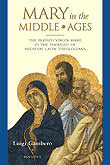







God never does anything without exceeding preparation. The two great
masterpieces of God are Creation of man and Re-creation or Redemption of man.
Creation was made for unfallen men; His Mystical Body, for fallen men. Before
making man, God made a garden of delights—as God alone knows how to make
a garden beautiful. In that Paradise of Creation there were celebrated the
first nuptials of man and woman. But man willed not to have blessings, except
according to his lower nature. Not only did he lose his happiness; he even
wounded his own mind and will. Then God planned the remaking or redeeming of
man. But before doing so, he would make another Garden. This new one would be
not of earth but of flesh; it would be a Garden over whose portals the name of
sin would never be written—a Garden in which there would grow no weeds of
rebellion to choke the growth of the flowers of grace—a Garden from which
there would flow four rivers of redemption to the four corners of the
earth—a Garden so pure that the Heavenly Father would not blush at
sending His Own Son into it—and this "flesh-girt Paradise to be
gardened by the Adam new" was Our Blessed Mother. As Eden was the Paradise
of Creation, Mary is the Paradise of the Incarnation, and in her as a Garden
were celebrated the first nuptials of God and man. The closer one gets to fire,
the greater the heat; the closer one is to God, the greater the purity. But
since no one was ever closer to God than the woman whose human portals He threw
open to walk this earth, then no one could have been more pure than she. In the
words of Lawrence Housman:
A garden bower in flower
Grew waiting for God's hand:
Where no man ever trod,
This was the Gate of God.
The first bower was red—
Her lips which "welcome" said.
The second bower was blue—
Her eyes that let God through.
The third bower was white—
Her soul in God's sight.
Three bowers of love
Now Christ from heaven above.
This special purity of hers we call the Immaculate Conception. It is not the
Virgin Birth. The word "immaculate" is taken from two Latin words
meaning "not stained." "Conception" means that, at the
first moment of her conception, the Blessed Mother in the womb of her mother,
St. Anne, and in virtue of the anticipated merits of the Redemption of her Son,
was preserved free from the stains of Original Sin.
I never could see why anyone in this day and age should object to the
Immaculate Conception; all modern pagans believe that they are immaculately
conceived. If there is no Original Sin, then everyone is immaculately
conceived. Why do they shrink from allowing to Mary what they attribute to
themselves? The doctrine of Original Sin and the Immaculate Conception are
mutually exclusive. If Mary alone is the Immaculate Conception, then the rest
of us must have Original Sin.
The Immaculate Conception does not imply that Mary needed no Redemption. She
needed it as much as you and I do. She was redeemed in advance, by way of
prevention, in both body and soul, in the first instant of conception. We
receive the fruits of redemption in our soul at Baptism. The whole human race
needs redemption. But Mary was de-solidarized and separated from that sin-laden
humanity as a result of the merits of Our Lord's Cross being offered to her at
the moment of her conception. If we exempted her from the need of redemption,
we would also have to exempt her from membership in humanity. The Immaculate
Conception, therefore, in no way implies that she needed no redemption. She did!
Mary is the first effect of redemption, in the sense that it was applied to her
at the moment of her conception and to us in another and diminished fashion
only after our birth.
She had this privilege, not for her sake, but for His sake. That is why those
who do not believe in the Divinity of Christ can see no reason for the special
privilege accorded to Mary. If I did not believe in the Divinity of Our
Lord—which God avert—I should see nothing but nonsense in any
special reverence given to Mary above the other women on earth! But if she is
the Mother of God, Who became Man, then she is unique, and then she stands out
as the new Eve of Humanity—as He is the new Adam.
There had to be some such creature as Mary—otherwise God would have found
no one in whom He could fittingly have taken His human origin. An honest
politician seeking civic reforms looks about for honest assistants. The Son of
God beginning a new creation searched for some of that Goodness which existed
before sin took over. There would have been, in some minds, a doubt about the
Power of God if He had not shown a special favor to the woman who was to be His
Mother. Certainly what God gave to Eve, He would not refuse to His Own Mother.
Suppose that God in making over man did not also make over woman into a new
Eve! What a howl of protest would have gone up! Christianity would have been
denounced as are all male religions. Women would then have searched for a
female religion! It would have been argued that woman was always the slave of
man and even God intended her to be such, since He refused to make the new Eve
as He made the new Adam.
Had there been no Immaculate Conception, then Christ would have been said to be
less beautiful, for He would have taken His Body from one who was not humanly
perfect! There ought to be an infinite separation between God and sin, but
there would not have been if there was not one Woman who could crush the
cobra's head.
If you were an artist, would you allow someone to prepare your canvas with
daubs? Then why should God be expected to act differently when He prepares to
unite to Himself a human nature like ours, in all things, save sin? But having
lifted up one woman by preserving her from sin, and then having her freely
ratify that gift at the Annunciation, God gave hope to our disturbed, neurotic,
gauche, and weak humanity. Oh, yes! He is our Model, but He is also the Person
of God! There ought to be, on the human level, Someone who would give humans
hope, Someone who could lead us to Christ, Someone who would mediate between us
and Christ as He mediates between us and the Father. One look at her, and we
know that a human who is not good can become better; one prayer to her, and we
know that, because she is without sin, we can become less sinful.
And that brings us back to the beginning. We have said that everyone carries
within his heart a blueprint of his ideal love. The best of human loves, no
matter how devoted they be, must end—and there is nothing perfect that
ends. If there be anyone of whom it is possible to say, "This is the last
embrace," then there is no perfect love. Hence some, ignoring the Divine,
may try to have a multiplicity of loves make up for the ideal love; but this is
like saying that to render a musical masterpiece one must play a dozen
different violins.
Every man who pursues a maid, every maid who yearns to be courted, every bond
of friendship in the universe, seeks a love that is not just her love or his
love but something that overflows both her and him that is called "our
love." Everyone is in love with an ideal love, a love that is so far
beyond sex that sex is forgotten. We all love something more than we love. When
that overflow ceases, love stops. As the poet puts it: "I could not love
thee, dear, so much, loved I not honor more." That ideal love we see
beyond all creature-love, to which we instinctively turn when flesh-love fails,
is the same ideal that God had in His Heart from all eternity—the Lady
whom He calls "Mother." She is the one whom every man loves when he
loves a woman—whether he knows it or not. She is what every woman wants
to be when she looks at herself. She is the woman whom every man marries in
ideal when he takes a spouse; she is hidden as an ideal in the discontent of
every woman with the carnal aggressiveness of man; she is the secret desire
every woman has to be honored and fostered; she is the way every woman wants to
command respect and love because of the beauty of her goodness of body and
soul. And this blueprint love, whom God loved before the world was made, this Dream
Woman before women were, is the one of whom every heart can say in its depth of
depths: "She is the woman I love!"
Related IgnatiusInsight.com Articles and Excerpts:
• The Virtually Venerable Fulton J. Sheen | Charles F. Harvey
• Mary in Byzantine Doctrine and Devotion |
Brother John M. Samaha, S.M.
• Fairest Daughter of the Father: On the Solemnity
of the Assumption | Rev. Charles M. Mangan
• The Blessed Virgin in the History of
Christianity | John A. Hardon, S.J.
• "Hail, Full of Grace": Mary, the Mother of Believers |
Joseph Cardinal Ratzinger
• Mary in Feminist Theology: Mother of God or Domesticated Goddess? |
Fr. Manfred Hauke
• Excerpts from The Rosary: Chain of Hope | Fr.
Benedict Groeschel, C.F.R.
• The Past Her Prelude: Marian Imagery in the Old
Testament | Sandra Miesel
• Immaculate
Mary, Matchless in Grace | John Saward
• The Medieval
Mary | The Introduction to Mary in the Middle Ages | by Luigi Gambero
• Misgivings About
Mary | Dr. James Hitchcock
• Born of the Virgin Mary | Paul Claudel
• Assumed Into Mother's
Arms | Carl E. Olson
• The Disciple
Contemplates the Mother | Erasmo Leiva-Merikakis
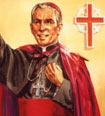 Archbishop
Archbishop Fulton Sheen (1895-1979) is considered by many to be the most influential
Catholic of the 20th century in America. Millions of people watched his
incredibly popular television series every week, "Life is Worth Living",
and millions more listened to his radio program, "The Catholic Hour".
Wherever he preached in public, standing-room-only crowds packed churches
and halls to hear him. He had the same kind of charisma and holiness that
attracts so many people to Pope John Paul II, who called Sheen "a loyal
son of the Church." Learn more about Archbishop Sheen by reading his
autobiography, Treasure
In Clay , or visiting the Archbishop
Fulton J. Sheen Foundation website.
September 7, 2013
A Love So Great It Seems Like Hate?
Readings:
• Wis 9:13-18b
• Ps 90:3-4, 5-6, 12-13, 14-17
• Phmn 9-10, 12-17
• Lk 14:25-33
I recently read a column by a young
Catholic who expressed frustration with the saying, “Love the
sinner, hate the sin.” She wrote that this seemed to make sense
initially but, she added, “I started to wonder why we need to hate
at all. Certainly, Jesus didn’t teach that. Jesus was all about
love.” She went a step further, saying, “When we start hating,
whether it is a person or an action, we stop recognizing the dignity
in the other person, which makes it easy to oppress them.”
This
seems rather reasonable at first glance. But if Jesus never expressed
hate, what are we to do with today’s Gospel, in which Jesus tells
the great crowds traveling with him to Jerusalem, “If anyone comes
to me without hating his father and mother, wife and children,
brothers and sisters, and even his own life, he cannot be my
disciple.” As Luke Timothy Johnson notes in his commentary, “the
language here is very strong,” for the Greek word used for
hate—misein—“is the opposite of ‘love’ (agapao)…”
How should we understand this blunt and
seemingly “unJesus-like” remark? First, we must work to free
ourselves from the common understanding of “love” and “hate”
as primarily having to do with feelings and raw emotion. When love,
for example, is defined as how we feel about someone or
something, both love and the object of my “love” are devalued and
damaged. How many marriages last when based on a love flowing from
strong emotion and romantic euphoria, not rooted in a commitment of
will and a mature acceptance of responsibility?
The two terms—love and hate—as
used in Luke’s Gospel, “denote attitudes and modes of action,”
Johnson explains, “not emotions.” Jesus was not a pop
psychologist; he was not concerned with talking about feelings, but
with responding rightly to truth. His are strong and hard words, but
they are best understood in light of his own actions. Did Jesus love
his disciples? The people of Israel? The world? The answer to all
three questions is emphatically, “Yes!” And yet his love for the
Father was so perfect, complete, and absolute that Jesus, at
different times and in various ways, spoke harshly to his disciples,
denounced the sins of Israel, and renounced the ways of the world.
And here we find a paradox within a
paradox, for while those actions might appear hateful to some, they
are the epitome of love, for love always wills the good of the other
despite the emotions involved. The man who truly loves God will never
despise, mock, or demean his friends or family. But his love for God
should be so consuming—so distinct and radical—that his love for
other people might seem hateful. When Jesus told Peter, “Get behind
me, Satan!”, it appears he is being unfair, even hateful. But his
next words are essential: “You are a hindrance to me; for you are
not on the side of God, but of men” (Matt. 16:23). Anything
hindering us from loving God is to renounced; anyone who insists on
taking the place of God in our lives must be rebuffed.
This teaching by Jesus builds upon many
of his earlier statements. It amplifies, for instance, his remark,
“For what does it profit a man if he gains the whole world and
loses or forfeits himself?” (Lk. 9:25). And it challenged those
following him to consider seriously the hard fact of the Cross. The
journey to Jerusalem was a journey toward suffering and death.
Everyone on the journey must take up and carry “his own cross,”
for only by the Cross do we enter into the Kingdom, the heavenly
family of God.
Jesus calls us to reject everything and
everyone who would keep us from God. That includes sin, of course; it
might also include some friendships and relationships. What may seem
like hate to others is evidence that Jesus is indeed all about real
and lasting love.
(This "Opening the Word" column originally appeared in the September 5, 2010, issue of Our Sunday Visitor newspaper.)
September 6, 2013
The Islamist Spring and the West’s Decline
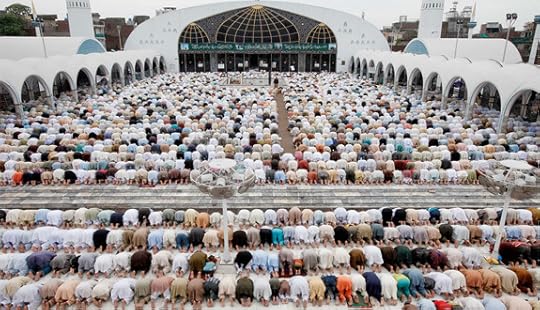
The Islamist Spring and the West’s Decline | Alvino-Mario Fantini | CWR
An interview with Robert R. Reilly, author of The Closing of the Muslim Mind
Robert R. Reilly is a senior
fellow at the American Foreign Policy Council. He has taught at the National
Defense University and has written for the Wall Street Journal, National
Review, Claremont Review of Books, and the Washington Post. He has
served in the White House as Special Assistant to the President (1983-85) and
was Senior Advisor for Information Strategy in the Office of the Secretary of
Defense (2002-06). He is a former director of the Voice of America and is a
member of the board of the Middle East Media Research Institute. Mr. Reilly is
the author of Surprised by Beauty:
A Listener’s Guide to the Recovery of Modern Music (2002). His most recent book, The
Closing of the Muslim Mind: How Intellectual Suicide Created the Modern
Islamist Crisis, was published
by the Intercollegiate Studies Institute in 2010.
Alvino-Mario Fantini: You recently wrote a best-selling
book entitled The Closing of the Muslim
Mind, which raises the question: How do we re-open the Muslim mind?
Robert R. Reilly
Robert R. Reilly: I had the opportunity
of asking one of the premier intellectual Muslim reformers the question: “If I
could give you all the resources you would need, personnel and money, and a
20-year period, tell me what you would do to turn around the Muslim world.” And
he paused and thought for a minute, and then he said, “I would re-Hellenize
it.” And that, of course, is the message in Pope Benedict XVI’s [2006]
Regensburg Lecture.
This man, who was from a very prominent Syrian
family—deeply learned both in Islam and Western philosophy—knew exactly the
nature of the problem and there are any number of other Muslim intellectuals
like him who do as well. The problem is they’re mostly living in exile because
it’s too dangerous for them to propose doing that in their own societies.
What is your assessment of the so-called Arab Spring?
Does it offer any hope—or reasons to worry?
I was just discussing this with an Egyptian the other
evening…and he’s very optimistic about the Arab Spring. I was very pessimistic
precisely because it doesn’t seem that the culture in the Middle East is going
to allow for the development of genuine democratic constitutional rule,
precisely because it hasn’t been re-Hellenized, precisely because it has not
restored the integrity of reason, precisely because majority Sunni Islam still
denies the existence of natural law—without which it is impossible to develop
sound constitutional theory. As I expressed to him, the problem is a deformed
theology that has produced a dysfunctional culture.
None of the intellectual currents in the Middle East are
headed in the right direction. They are headed in the Islamist direction. This
is an “Islamist Spring.” The Muslim Brotherhood’s offshoots have so far either
won these elections or gained a large plurality in them. The signs are not
good. But they are perfectly logical in terms of the principles on which these
Muslim Brotherhood organizations operate. So they’re headed backwards.
Backwards is where they want to go.
As the Arab Spring has toppled regimes in the region, it
has created a situation of instability and great uncertainty in many countries.
There is a power vacuum slowly being filled by new groups. What’s coming next?
Continue reading on the CWR site.
Homosexuality, Identity, and the Grace of Chastity
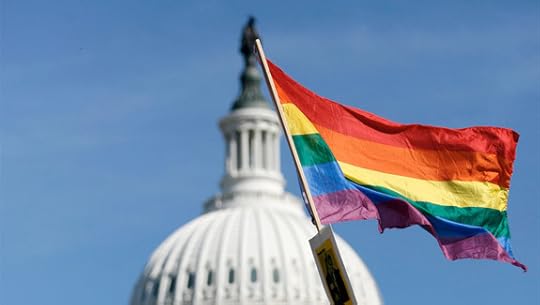
Homosexuality, Identity, and the Grace of Chastity | Carrie Gress | CWR
Courage’s Fr. Paul Check on why chastity is an essential virtue for those with same-sex attraction—and for all Christians.
St.
Augustine is famous for having prayed, “Lord, make me chaste, but not yet.” Father
Paul Check, the director of Courage, suggests that chastity, like justice and
mercy, is indeed part of the Good News of Christ and to ignore it is
self-defeating.
The
Courage apostolate ministers to people with same-sex attraction who want to
live by the Catholic Church’s sexual teachings, providing self-governed
and anonymous group meetings around the country.
Father
Check, who served as an officer in the Marine Corps prior to being ordained to
the priesthood in 1997, spoke recently with Catholic
World Report about the Church’s wisdom in not reducing persons to an
identity based solely upon their sexual appetites, and how the average Catholic
can respond to the aggressive social agenda of the gay lobby.
Father Paul Check, director of Courage
CWR:
Within Courage, you make a clear distinction between same-sex attraction and
the gay lifestyle. Can you clarify the difference?
Father Check:
The most important question ever asked in human history was asked by Our Lord
when he said to the apostles, “Who do you say that I am?” It is the question of
identity, because it is from an understanding of identity that we then know how
to live in a way consistent with that identity. I won’t say that it is always
easy, because we have concupiscence, but in order for us to understand the
proper way of asking, we first have to clearly answer the question of being.
With
regard to the human person, the question of “Who am I?” is best answered with
the understanding that we are children of God redeemed by the blood of Christ
and called to be his disciples, and we are invited to grow in this life of
grace and glory in the life to come. There is the foundation of the most
important or essential part of our identity.
Now
there are other things that make up our identity as well. Our human family, and
where we are from geographically. These things are also important but not as
important as the fundamental question of our identity, our being children of
God.
We
are created as sexual beings and this story is told to us in the book of
Genesis, which is not a science book, of course, and does not tell us in
precise terms how man came to be but rather precisely who we are and who we are
intended to be and to whom we are to look for an understanding of our identity.
In that Genesis story it is made plain that God in his wisdom divided the human
race in such a way that human nature is expressed in the masculine and the
feminine. This is a very rich theological and anthropological question. But for
our purposes here, while there is such a thing as human nature, that nature is
always expressed very concretely in a person—a person that is either masculine
or feminine, so that sexual identity is also something that is integral to who
the person is. And in order to know who we are and how that sexual identity is
properly expressed we go back to the Genesis story and learn about the union of
man and woman, the fruitfulness of God in his plan, and how his gifts of
fertility are associated with the sexual faculty and are inherently bound up
with sexual intimacy.
With
that preamble, the reason that the Church, it seems to me, avoids the labels of
“gay,” “homosexual,” and “lesbian” as nouns is because in her maternal wisdom
and charity, and in following the story of who man is, she does not want to
collapse someone’s identity into only their sexual appetite. That seems unjust
and uncharitable. It takes a bit more charity to say that a person has same-sex
attraction than to use the labels that are very popular in the culture today.
In
saying this, of course, I am not in any way minimizing the strength, the
intensity, the duration or the frequency of the feelings of same-sex attraction
and how important these feelings are to someone’s self-understanding. We only
want to give same-sex attraction its proper label. Not too much, but clearly
not too little.
CWR:
As a result of that, what do you see in the gay lifestyle that then defeats the
ability to have a life of authentic happiness?
September 5, 2013
Four lessons learned from the talentless, cynical huckster Miley Cyrus

by Carl E. Olson | CWR blog
It would be easy to pick on Miley Cyrus, she being the One Who Would Writhe Her Way to the Twerking Throne. It would also be easy, and understandable, to lament her recent—what shall we call it?—performance/lap dance at MTV Music Video awards (say, didn't MTV stop airing music videos in 1993 or so?). If you've seen it, you likely don't want to again; if you haven't seen, don't bother. Please don't bother.
Victor Davis Hanson both laments and analyzes in an NRO essay yesterday, "Miley Cyrus and Ugly Sex":
An older generation used to call the boredom of bad habits “reaching rock bottom”; the present variant perhaps is “jumping the shark” — that moment when the tiresome gimmicks no longer work, and the show is over.
In a moral sense, Miley Cyrus reached that tipping point for America, slapping us into admitting that most of our popular icons are crass, talentless bores, and that our own tastes, which created them, lead nowhere but to oblivion.
After all, what does an affluent and leisured culture do when it has nothing much to rebel against?
A good question. And a question worth pondering, as Hanson ably does. But of interest to me here is what Cyrus had to say about her tasteless tease, and what is says about what so many Americans apparently find important and meaningful in life. Three days after acting like a porn star on crack in a stuffed animal store, the young Cyrus provided this deep insight (warning: tasteless stuff everywhere) into the matter:
I don't pay attention to the negative. Because I've seen how this plays out. How many times have we seen this play out in pop music? You know what happens. Madonna's done it. Britney's done it. … Anyone who performs, that's what your looking for; you're wanting to make history. Me and Robin [Thicke] said the whole time, "You know we're going to make history right now." It's amazing, I think, now we're three days later and people are still talking about it. They're overthinking it. You're thinking about it more than I thought about it when I did it. Like, I didn't even think about it, 'cause that's just me.
Cyrus is going to be roundly mocked by some for these silly comments, but I think she's provided a modest service for those folks who are scratching their heads, asking, "Why? Wha...? Huh?" How so? Because she outlined, without resorting to philosophical jargon or esoteric analogies (as if she could resort to such), the basic worldview of so many twenty-somethings (and thirty-somethings). And that worldview consists of these basic premises and assumptions:
September 3, 2013
On the two different visions of religious life among sisters since Vatican II
Ann Carey, author of Sisters in Crisis: Revisited | From Unraveling to Reform and Renewal (Ignatius Press, 2013), answers questions from Matt C. Abbott of Renew America:
1. What inspired you to write Sisters in Crisis?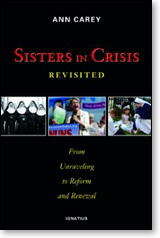 Ann Carey: I always had an interest in sisters, for they had been my teachers from kindergarten through college. I was writing for Our Sunday Visitor in 1992 when I was asked to write an article about the Vatican approval of a second superiors' conference for U.S. women religious – the Council of Major Superiors of Women Religious. U.S. women religious already had a superiors' conference – the Leadership Conference of Women Religious (LCWR). That was the first time the Vatican had ever recognized more than one superiors' conference in the same country, so I wondered why this happened.
Ann Carey: I always had an interest in sisters, for they had been my teachers from kindergarten through college. I was writing for Our Sunday Visitor in 1992 when I was asked to write an article about the Vatican approval of a second superiors' conference for U.S. women religious – the Council of Major Superiors of Women Religious. U.S. women religious already had a superiors' conference – the Leadership Conference of Women Religious (LCWR). That was the first time the Vatican had ever recognized more than one superiors' conference in the same country, so I wondered why this happened.
In researching the article I found that two different visions of religious life had evolved among sisters since the close of Vatican II in 1965. Thus, the Vatican erected the second superiors' conference to accommodate the sisters who were living the Church's classic model of religious life and did not embrace the evolving vision of a diverse religious life espoused by the LCWR.
I became very interested in why sisters had taken these two very different paths of renewal, and I realized this was an important story that had never been told completely. I live near the University of Notre Dame, where the archives of many organizations of women religious are deposited, so I had rich archival resources available for researching a book. The first edition was published in 1997, and the second, updated edition in 2013.
2. What role, if any, did the Second Vatican Council play in this crisis of faith and leadership?
Continue reading the interview on the RenewAmerica.com site.
A letter from Trappist nuns in Syria: “Blood fills our streets, our eyes, our hearts”
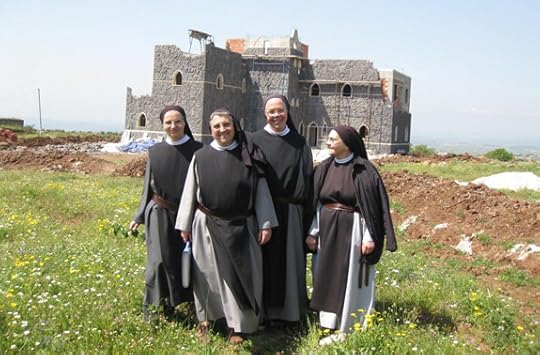
A letter from Trappist nuns in Syria: “Blood fills our streets, our eyes, our hearts” | Alessandra Nucci | CWR blog
In March 2005 a small group of nuns from the Cistercian Monastery of Valserena in Tuscany moved to Aleppo, Syria, to found a new monastic community there. The nuns were inspired to take up the legacy of seven monks who were martyred in 1997 in Tibhirine, Algeria. The sisters wanted to follow the example set by these men, who had totally dedicated their lives to God and to their beloved Algerian neighbors, both Christian and Muslim.
The sisters’ guiding Scripture is John 10:16: “There are other sheep I have that are not of this fold, and I must led these too. They too will listen to my voice.”
Once they had settled in Aleppo, with the blessing of both the Latin Apostolic Vicar and the Maronite bishop of Tartous, the sisters gained a new awareness of the importance of helping Christian Arabs remain in the Middle East, as well as a respect for the diversity of their traditions. Their project was, and continues to be, establishing a permanent monastery on the land they bought near the Syrian border with Lebanon, in a Maronite village named Azeir, atop a hill, far from the big cities. The monastery is at the service of isolated Christian communities, in a land which is predominantly Muslim but which is home to the most ancient of Christian traditions.
To the sisters, Syria represents the meeting place of East and West, the place where Christianity began and then spread to Asia Minor, Greece, Rome, and then Armenia and India—all the way to China, with saints such as such as Afraate, Ephraim, Cyrus, Simeon Protostilite, Maron, Isaac of Niniveh, and others who followed in their footsteps, such as John Chrysostom and John Damascene.
It is this tradition the sisters wish to honor and perpetuate, persevering in their mission despite the fear and the hardship: to keep the monastery going and provide those who desire it with a chance to spend a few days there, with a church to go to.
These nuns have been providing a much-needed independent perspective on the tumultuous events going on inside Syria, in eye-witness reports published on their website and in the Italian bishops’ newspaper, Avvenire.
Here is a translation of a letter written on the 29th of August, in which the sisters seem to be holding their breath as President Obama deliberated about what, if any, action would be taken in Syria by the United States.
September 1, 2013
The Church and the Syrian Refugees
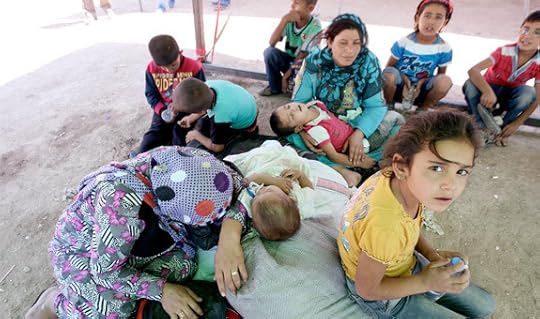
The Church and the Syrian Refugees | William Patenaude | Catholic World Report
“We don’t help people because they are Catholic ... We help people because we
are Catholic.”
In a region that has seen increasing threats to ancient Christian
communities, the Catholic Church is helping many of the two million
refugees of Syria’s civil war. Besides physical aid, Church workers
offer the Syrians the simple truth that they haven’t been
forgotten—that they are loved and will be cared for.
Most refugees are Muslim, children
Sean Callahan, the Chief Operating Officer for Catholic
Relief Services (CRS)—the humanitarian arm of the United States
Conference of Catholic Bishops—manages the organization’s
overseas operations. For the past two years this has included caring
for the displaced Syrians. He has met many of the once mostly
middle-class people now living without a home or a sense of what is
to become of them. Callahan describes the refugees as “vulnerable.”
This drives CRS workers and local Christian communities to live the
Beatitudes in a region besieged by the very opposite.
Syrian refugees—the vast majority of which are Muslim—are
scattered throughout the neighboring nations of Lebanon, which is now
home to approximately 700,000 refugees; Jordan and Turkey, which
have taken in 500,000 each; and Iraq, which has opened its borders to
allow 160,000 Syrians. Some refugees have also found shelter in Egypt
while a small number seek protection in Europe.
Half of the refugees are children. Of the adults, most are elderly
and women. Men have typically stayed in Syria to fight or to protect
family property or businesses. Many of those are dead or feared to
be. To date, some 100,000 people have died in the conflict and
thousands of families are divided with no means of finding each other
or communicating at all.
The vast majority of refugees have either integrated themselves into
cities, villages, or communities. Some have joined family or friends.
Others live in what are sometimes known as “makeshift camps,”
whether in cities or in rural areas. Host nations provide a variety
of aid as their resources allow. Jordan offers the most formally
structured camps while other nations provide more modest ones. Some
Syrians who once owned comfortable homes now live in shelters made
from sewn burlap sacks. Basic necessities like food, water,
sanitation, and hope for a better future are scarce.
Callahan recalls meeting a woman in her sixties. Her husband and sons
had been killed in the violence and she now cared for her daughters,
daughters-in-law, and grandchildren. “What am I to do?” she
asked. “How do I support my family?”
August 31, 2013
Feasting with Humility
A Scriptural Reflection on the Readings for Sunday, September 1, 2013 | Carl E. Olson
Readings:
• Sir 3:17-18, 20, 28-29
• Ps 68:4-5, 6-7, 10-11
• Heb 12:18-19, 22-24a
• Lk 14:1, 7-14
Years
ago I came up with a little line that I use from time to time, if a
conversation warrants it: “I’m especially proud of my humility!”
It is, of course, meant to be humorous and self-deprecating, but it is also meant
to highlight how exceedingly difficult it is to truly be humble.
After all, if I am aware that I am humble, am I actually humble?
“True humility,” explained St. Francis de Sales in his
Introduction to the
Devout Life, “makes
no pretence of being humble, and scarcely ever utters words of
humility.” This seems so counter-intuitive, in part because,
wounded by sin, we are drawn toward pride and arrogance, toward being
praised, flattered, and recognized.
Yet
real humility requires that we examine and know ourselves, and thus
see who we really are. “Humility is both one of the most difficult
of virtues both to attain and to ascertain,” wrote Ven. John Henry
Newman (soon to be canonized a saint by Pope Benedict XVI during his
visit to England). “It lies close upon the heart itself, and its
tests are exceedingly delicate and subtle. Its counterfeits abound.”
How true! We see examples of false humility all around us—and
within us. If there is one thing I know about myself, it is that I
have a tenuous, trying relationship with humility!
Jesus,
the greatest observer of human behavior and the human heart, saw how
the guests at the home of a leading Pharisee were jostling for
positions of honor at the dinner table. He took the opportunity to
chide them about their priorities and their pride. As was so often
the case, Jesus drew upon the Scriptures, even while drawing out
deeper meanings from them. Here, he very likely had this passage from
the Wisdom literature in mind: “Do not put yourself forward in the
king's presence or stand in the place of the great; for it is better
to be told, ‘Come up here,’ than to be put lower in the presence
of the prince” (Prov. 25:6-7). Similar statements can be found in
rabbinic teachings.
But
Jesus focus was not, in the end, on seating arrangements at dinner,
for he refers instead to “a wedding banquet.” And the banquet
Jesus had in mind is not an earthly one, but a heavenly one, the
“festal gathering” in the heavenly Jerusalem (Heb. 12:22). His
primary concern was not social etiquette, but humility in the face of
divine judgment and the Last Day. “For you will be repaid,” he
told the guests, “at the resurrection of the righteous.” The
clear implication is that the righteous are not self-seeking and
prideful.
Most
people are familiar with this well-known, paradoxical statement from
today’s Gospel reading: “For every one who exalts himself will be
humbled, but the one who humbles himself will be exalted.” Notice
that self-exaltation is always false exaltation. Our attempts to
exalt ourselves will eventually crumble, for pride goes before the
fall. Yet we are able to humble ourselves, to seek self-abasement and
meekness of spirit.
True
humility comes from recognizing who we are in relation to God, the
Creator of heaven and earth. “Meekness in itself is nought else,
but a true knowing and feeling of a man’s self as he is,” wrote
the anonymous author of The
Cloud of Unknowing.
Humility includes realizing the fragile and temporal nature of our
lives here and now. It means recognizing the limits of our abilities
and knowledge, as we hear in today’s reading from Sirach: “What
is too sublime for you, seek not, into things beyond your strength
search not.” The dominant secular culture says otherwise; it seeks
in countless ways to push beyond the boundaries of morality, natural
law, and divine revelation—as if such madness will lead to anything
but disaster and spiritual destitution.
“Humility,”
said St. Bernard of Clairvaux, “is the mother of salvation.” This
goes right to the heart of today’s readings. Without humility, we
starve; with humility, we feast.
(This "Opening the Word" column originally appeared in the August 29, 2010, edition of Our Sunday Visitor newspaper.)
August 30, 2013
New: "The Relevance and Future of the Second Vatican Council" by Marc Cardinal Ouellet
Now available from Ignatius Press:
The Relevance and Future of the Second Vatican Council
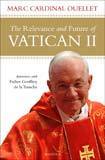
by Marc Cardinal Ouellet
• Also available in Electronic Book Format
Fifty years after the opening of the Second Vatican Council, Cardinal Marc Ouellet-considered by many to have been a top candidate to succeed Pope Benedict XVI-gives his thoughts on the Council and what the Vatican II means for us today. In interviews with French priest Fr. Geoffroy de la Tousche, Cardinal Ouellet speaks both personally and professionally about the state of the Church since the Council, explaining what went wrong-and right-in the implementation of the Council's teachings.
Ouellet discusses his own life, including his childhood in post-colonial Quebec, the search for meaning leading to his personal encounter with Christ, his vocation to the priesthood, being a professor in Latin America and Rome, and his more recent positions as archbishop of Quebec, prefect of the Congregation for Bishops, and president of the Pontifical Commission for Latin America. Drawing on his experience as both a formator of priests and a professor at the John Paul II Institute for the Family, Ouellet speaks of the significance of married love, the meaning of consecrated life, and the spousal nature of the priesthood. He illuminates these realities with the teachings of the Council. Among other topics, the Cardinal discusses his acquaintance with popes John Paul II and Benedict XVI, his experience on the Pontifical Council for Christian Unity, and his admiration for the youth today.
The interview continues with questions about the Council's four Constitutions and the Council in general, leading to a discussion of a wide range of topics including liturgy, ecumenism, evangelization, the work of the laity, new movements and communities, vocations, celibacy, human dignity, war and justice, ecology, sin, and the Eucharist. Moving with clarity and ease between theological realities and personal impressions, Cardinal Ouellet discusses the state of the Church today with points that are challenging, edifying, and full of hope.
Cardinal Marc Ouellet is the prefect of the Congregation for Bishops and also president of the Pontifical Commission for Latin America. He was ordained in 1968 and is a priest of the Society of Saint-Suplice. After serving over 20 years as a university and seminary professor, he was appointed Archbishop of Quebec in 2002 and created cardinal by Pope John Paul II.
Fr. Geoffroy de la Tousche was ordained in 1998 and is a priest of the Diocese of Rouen, France. In 2002, he completed a doctorate in dogmatic theology at the Pontifical Gregorian University on the subject of bishops as addressed in the Vatican II Constitution Lumen Gentium.
Carl E. Olson's Blog
- Carl E. Olson's profile
- 20 followers



